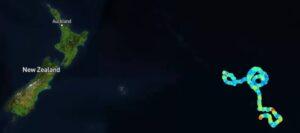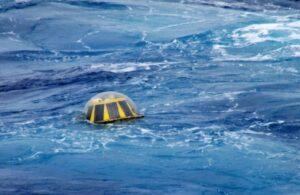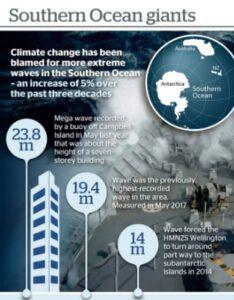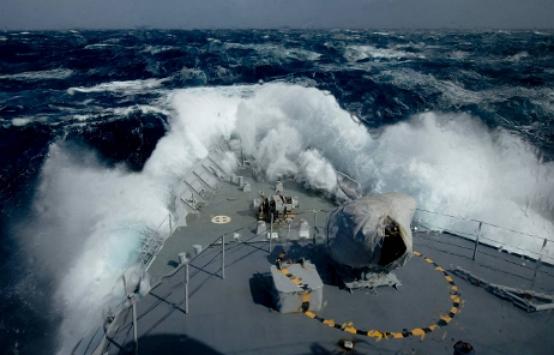State-of-the-art buoys placed in New Zealand’s ocean waters have detected exceptionally large waves this year, including a rare “one-in-3000-year” wave near Napier and a colossal wave towering four storeys high in the eastern region of the country.
Positioned along New Zealand’s coastlines and even in treacherous waters hundreds of kilometers south of the country, the buoys are serving a crucial role in aiding scientists to improve their models and predictions. In the midst of a series of extraordinary weather occurrences this year, these buoys have provided extraordinary data.
During the destructive ex-tropical Cyclone Gabrielle in February, wave buoys positioned off the Whangārei coast captured astonishing wave measurements. The maximum wave heights reached nearly 10 meters, while the significant wave heights averaged just over 6 meters. Maximum wave height represents the largest individual wave recorded, measuring from its peak to trough, while significant wave height provides an average of the largest one-third of waves, aligning well with visual estimations.

During the passage of ex-tropical Cyclone Gabrielle, the Wave Ride Buoy at the Port of Napier recorded a significant wave height of 6 meters. However, the buoy unfortunately broke free from its moorings shortly after. Dr. Séverin Thiébaut, an oceanographer from MetOcean Solutions, stated that their analysis indicates that such a sea state, with wave heights of six meters, would occur on average only once every 3000 years at the location of the Wave Rider buoy.
“While the frequency of these events may increase due to climate change, they still remain rare and are often not considered in retrospective models.”
Moving to a different location, an adrift buoy situated east of the Chatham Islands captured a massive wave on April 29, boasting a significant wave height of 13.6 meters, roughly equivalent to the height of a four-story building.
On April 16 and March 8, the same drifting buoy also detected waves of comparable heights. However, these measurements pale in comparison to the record-breaking maximum wave height ever recorded in the Southern Ocean. In May 2018, amidst a massive storm, a colossal wave towering at 23.8 meters was observed near Campbell Island.

During the winter months, these waves reached staggering heights, averaging over 5 meters and frequently surpassing 10 meters. In some instances, it is believed that they may have even exceeded 25 meters. Waves exceeding 20 meters were extremely dangerous for ships and posed significant hazards.
In 2014, the HMNZS Wellington encountered waves as high as 14 meters, resulting in the ship having to alter its course when en route to the subantarctic islands. To navigate through such turbulent waters, ships typically adopted a strategy of sailing directly into the oncoming waves. Dr. Brett Beamsley, the general manager of MetOcean Solutions, noted that waves of this magnitude could be occurring regularly in the Southern Ocean, although there is currently no direct means of measuring them.
“The global satellite altimeter data we have access to allows us to measure the sea surface altitude, providing some information about wave height. However, we are limited by the coverage of these observations, and they seldom align with the peak of storm events,” explained Dr. Brett Beamsley, general manager of MetOcean Solutions.
To generate waves of such magnitude, three key factors are required: high wind speed, a substantial expanse of water for the winds to traverse (known as fetch), and a consistent wind direction.
“The larger these factors are, the more significant the waves will become,” Beamsley emphasized. “In the end, it is the wind that propels the waves.”
The Southern Ocean, particularly beyond latitude 40 south where the “roaring 40s,” “furious 50s,” and “screaming 60s” prevail, is renowned for hosting the most potent average winds worldwide. With the ongoing effects of climate change, its capacity to generate waves is only escalating.

A recent study revealed a 5% increase, equivalent to 30cm, in extreme waves in the ocean over the past three decades. Simultaneously, the region has experienced a rise in stormy conditions, accompanied by gustier winds with a strengthening rate of 1.5m per second.
Furthermore, a separate study conducted in 2020 projected that as the planet continues to warm, stronger storm winds will be triggered, leading to larger and more frequent extreme waves over the next 80 years. The Southern Ocean is expected to witness the most significant increases in wave intensity.
While the Southern Ocean is known for its colossal waves, it’s important to note that significant waves can also occur closer to the shores of New Zealand, particularly during the passage of deep ex-tropical cyclones or subtropical lows, accompanied by intense wind speeds.
Wave buoys stationed at various locations around New Zealand often record significant wave heights ranging from five to seven meters, with individual waves potentially reaching nearly double that size, according to Beamsley.
The moored buoys used for wave measurement provide essential data on wave heights, periods, and directions. Equipped with vertical accelerometers to gauge buoy movement and tilt sensors to determine direction, these buoys continuously collect data and transmit it via satellite or cellular networks. This technology enables real-time monitoring and analysis of wave conditions in the ocean.
According to Beamsley, the data obtained from these buoys plays a crucial role in comprehending the present conditions of the marine environment and enhancing the accuracy of forecast models.
“These observations are also invaluable for verifying and validating ocean models, allowing us to fine-tune and enhance their performance,” he added.
In a broader context, the data is aiding scientists in assessing the vulnerability of our coastlines to large waves and swells, specifically in relation to storm surge, inundation, and erosion.
“In the future, this situation is expected to worsen due to rising sea levels and coastal erosion,” Beamsley commented.
Unlike many other countries, New Zealand does not have a unified wave buoy network operated centrally to enhance the understanding of the marine environment.
“Buoy deployments in New Zealand are scattered and rely on funding from individual ports or regional councils,” Beamsley explained.
MetOcean Solutions, the oceanographic division of MetService, has collaborated with the New Zealand Defence Force (NZDF) in the installation of its wave buoys in the Southern Ocean. Additionally, MetService has actively participated in the Global Drifter Programme by deploying drifting buoys from the US National Oceanic and Atmospheric Administration in the Tasman Sea and the Southern Ocean, utilizing cruise liners and container ships for this purpose.
Following the disruptions caused by the pandemic, the count of operational drifting buoys in the vicinity of New Zealand declined to a mere eight. However, with the valuable support of the New Zealand Defence Force (NZDF), over 40 drifting buoys have been deployed since late 2021 to bolster the monitoring efforts in the region.

